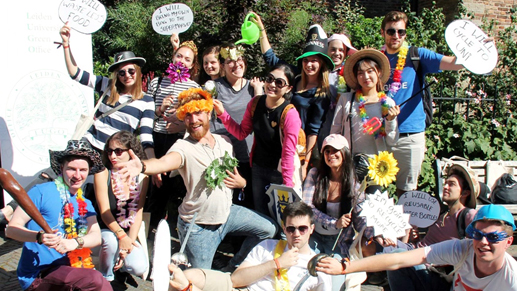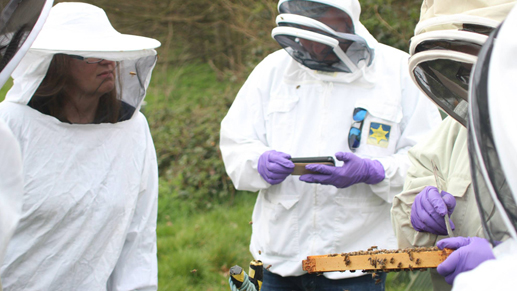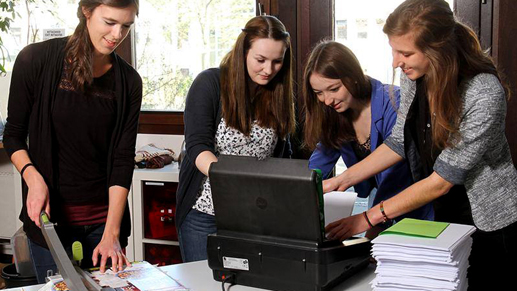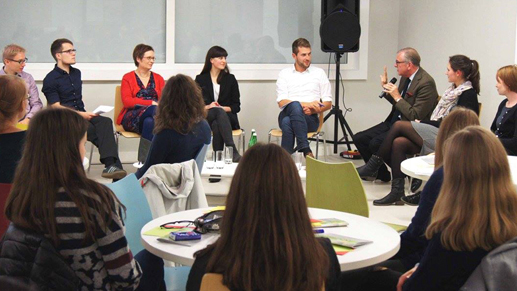What is education for sustainable development? (Read our short guide)
Education for Sustainable Development provides an exciting vision of an interdisciplinary and learner-centred way to empower students to advance a pro-social and environmental agenda in their organisations, communities and personal lives. In this post, you learn more about how to define this concept.
1. Why is education for sustainable development important?
2. What is education for sustainable development?
2.1 Learning outcomes: Creating change makers, rather than passive consumers
2.2 Learning content: Investigating topics from an interdisciplinary perspective
2.3 Pedagogy: Interactive, learner-centred and action-oriented (+ fun)
3. How to implement it? Take a whole-institution approach!
1. Why is education for sustainable development important?
Globalisation and digitalisation connect the world. As a result, cultures mix, economies grow and communication speeds up. The world becomes increasingly complex and uncertain.
In addition to these mega-trends, humanity is altering the planet’s climate, animals and landscapes in unprecedented ways, and threatening all life on earth.
We’ve entered the Anthropocene – a new geological area shaped by humanity:
Given these global developments, students have an increasing demand for education that goes beyond teaching knowledge and skills just to find a job.
Above all, students need new perspectives to be able to understand the rapidly changing world they live in. In addition, they need to participate in this world. Many of them also want to help reduce poverty, protect the environment and create inclusive societies. To realise this ambition, a new approach to education is needed.
Sustainability education provides this alternative approach, aiming to educate students as global citizens for sustainable development.
Sign-up to the FREE online course to establish your Green Office
5 weeks. One email per week. Unsubscribe at any time. By signing up, you agree to our data policy.
2. What is Education for Sustainable Development?
Academics and practitioners can’t agree on a shared definition. Like sustainable development or sustainability, the concept means different things to different people (surprise!).
So, just pick a definition that suits you best. We like UNESCO‘s definition:
“Education for Sustainable Development empowers learners to take informed decisions and responsible actions for environmental integrity, economic viability and a just society, for present and future generations, while respecting cultural diversity.”
That sounds wonderful, but, it’s also a bit of a mouthful. So, let’s try to look at the different elements of this definition:
(2.1) Learning outcomes
(2.2) Learning content
(2.3) Pedagogy
2.1 Learning outcomes: Creating change makers, rather than passive consumers
As the definition above illustrates, the concept of Education for Sustainable Development aspires to “empower learners to take informed decisions and responsible actions”. As opposed to educating obedient consumers or employees, this type of teaching and learning wants students to think and act for themselves.
Other scholars and practitioners write that students should be able to become “change agents” or “change makers”. Those are people who don’t passively observe what is happening in society but are able to act, intervene, and ask critical questions.
This ambition requires different learning outcomes, compared to more “traditional” education. A huge body of literature exists around what learning outcomes Education for Sustainable Development strives for.
Arnim Wiek and colleagues conducted a study we really like. They looked at different ways to define the concept of Education for Sustainable Development and synthesized common learning outcomes that students are expected to learn.

Sustainability education empowers students to shape the world
System’s thinking
Systems thinking gives students a lens to look at the world in all its complexity, messiness and uncertainty. For example, when studying energy production from a system’s perspective, then students would identify things like the system’s actors, dynamics, leverage points, thresholds or feedback loops. Check out Thinking in Systems: A primer, by Donella H. Meadows, as a great introduction.
Anticipatory thinking
Anticipatory thinking enables learners to think creatively and critically about the future. How will the environment be impacted when current consumption trends continue? How would a sustainable world look like? What are the unintended consequences of sustainability policies? Among others, students learn about scenario planning, transition management, modelling, and simulations.
Normative competence
Students learn to define for themselves how the world ought to be and what sustainability means to them. To achieve this, students learn about topics including climate justice, ethics, multi-criteria assessment or inter-generational equity. This enables them to, among others, argue to what extent products, companies, goals or systems contribute to sustainability or not.
Strategic competence
Sustainability education teaches students how to ‘get things done’. This is why they need to learn how to, among others:
- Design sustainability projects, policies, and campaigns;
- Navigate the complexities of multi-stakeholder processes;
- Overcome resistance and deal with criticism;
- Or continue to reflect on and monitor change processes.
Interpersonal competence
Change only happens through groups, teams or communities that are mobilised around a common cause. To become sustainability leaders, students need to inspire followers, negotiate with opponents, build alliances and communicate across cultures. Therefore, they need to learn about topics like team-work, partnerships, leadership, democracy or participation.
In this sense, the role of Education for Sustainable Development is to achieve that students can think and act for themselves and with others to work on a more sustainable world. For this, students need to be able to think and act critically, holistically and collaboratively.
But, how do you achieve these learning outcomes? That’s why this concept requires a different kind of pedagogical approach.

Education for sustainable development creates change makers, rather than passive consumers
2.2 Learning content: Investigating topics from an interdisciplinary perspective
Learning content describes what students learn. As the definition of UNESCO illustrates, the goal is that students learn about topics in an interdisciplinary way, from an economic, social and environmental perspective.
Let’s look at an example:
You can learn about economic growth purely from an economic perspective, looking at its economic drivers and consequences. But if you want to learn about economic growth, using the concept of Education for Sustainable Development, then you should learn about the social implications of economic growth, such as its impact on income (in)equality, well-being and health. Of course, you should also learn about the environmental perspective, analysing how economic growth impacts the environment in a positive or negative way.
This is the cool thing about Education for Sustainable Development: It makes education so much more interesting!
You can take literally any topic and look at it from an economic, social and environmental perspective. As a result, you don’t only see the world from the perspective of one discipline, but you obtain a richer picture of reality, by drawing on the insights from multiple disciplines.

Students learn to investigate topics from an interdisciplinary perspective
2.3 Pedagogy: Interactive, learner-centred and action-oriented (+ fun)
Pedagogy describes the practice or method of teaching. Different to the teaching content, it doesn’t describe what students learn, but how they learn.
A question to you: You take 200 students, put them into a lecture hall, and have a professor lecture 3 hours non-stop about economic growth from an economic, social and environmental perspective. Is this Education for Sustainable Development?
Yes, because the students learn about the topic from an interdisciplinary perspective.
No, because they probably won’t remember a lot, due to the method of teaching.
An interactive, learner-centred, and action-oriented pedagogy is the third generally agreed upon element of Education for Sustainable Development.
To put it plainly: students shouldn’t sit in a lecture hall all day, listening to presentation after presentation! On the contrary, they should work collaboratively on group assignments, solve real-life problems for an external client, go on excursions or discuss problems in small group seminars.
For examples:
- Engineering students could develop plans for how to improve recycling on campus,
- Pedagogy students could create a curriculum to teach students on the Sustainable Development Goals,
- Art students could give theatre performances around issues of environmental justice,
- Sports students could propose ideas on how to advance healthy and sustainable foods and catering,
- Business students could advise local companies on how to make production processes waste free.
(Also check out our blogpost on 80 sustainability research topics that you could consider for a paper.)
The teacher is more a facilitator, rather than a knowledge provider. The student much more active and responsible, rather than being a passive recipient of knowledge.

Education for sustainable development is interactive, learner-centred and action-oriented
3. How to implement it? Take a whole-institution approach!
Sustainability education is not only about integrating sustainability into the curriculum. It demands that educational institutions take a holistic approach to rethink the curriculum, governance, campus operations and community engagement:
Reorient the curriculum towards sustainability education
- Make an overview of what courses at your university or college already incorporate the ideas of education for sustainable development (You can use our assessment framework as guidance);
- Organise a conference or workshop to share your findings and engage teachers in a discussion;
- Find teachers, professors or faculty deans who want to work with you to reorient their curriculum towards sustainability.
Embed sustainability into the organisational culture, policy, and structure
- Develop a shared definition or vision of what type of graduates your university or college wants to create;
- Convene a working group to further education for sustainable development;
- Develop an action with clear projects, responsibilities and a budget to realise innovative educational initiatives.
Take campus operations as a living laboratory for learners to learn about sustainability
- Use the campus and buildings as a living laboratory for students doing course projects on sustainability issues at the university itself (See for instance the Living Lab Programme at Utrecht University for inspiration);
- Realise sustainability projects on campus and have students study their implementation and impacts as part of course work.
Help the local community to become more sustainable
- Organise a sustainability day for students and local citizens, involving initiatives and organisations in the city;
- Have students develop solutions to sustainability challenges of companies, civil society organisations or the city administration;
- Empower students to run workshops on sustainability topics for children in school or kindergarden.
Realising education for sustainable development in these dimensions requires that you take as whole-institution approach. This requires that sustainability education becomes a priority for educators and students, as well as support staff and managers. It also requires that you involve students, staff and local citizens.

Sustainability education engages teachers, students, and management
We suggest you think about the role of Education for Sustainable Development in your curriculum, school or university. Consider using it, since it provides an exciting vision of an interdisciplinary and learner-centred way to empower students to advance a pro-social and environmental agenda.
Learn more
You might also be interested in these topics:






